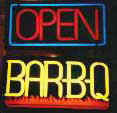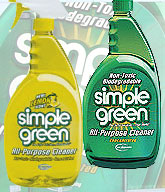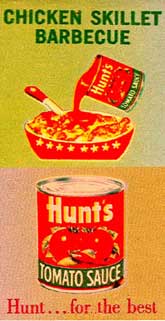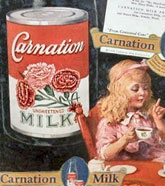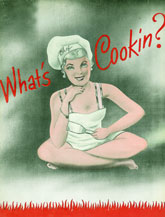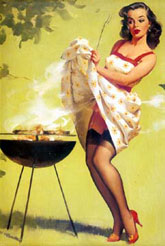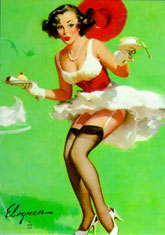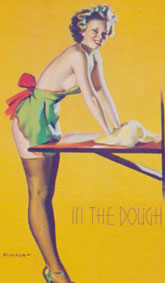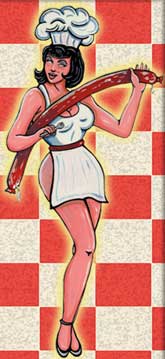Contact BBQbyDan
www.BBQDan.com
Search
KCBS BBQ Cook-Off Info
Recipes,
Smoking Meats
Recipes, Grilling
|
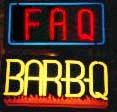 |
FAQ OF THE INTERNET BBQ LIST Version 2.0 Section 10.5 Turkey Breasts, Legs, Whole
turkey, Brining, |
--------------------
[Can I successfully smoke a turkey breast in my smoker?]
Danny Gaulden--
Try this next time you do a turkey breast. Before you rub or season the breast, rub it all over with soft butter, shortening, etc. Then apply your favorite rub, and place it in the smoker. Two or three times while the turkey is smoking, brush on more butter. When the meat reaches 165F internal temperature, take it off, wrap it up, and that's it. Promise it will turn out right.
--------------------[Do your smoked turkey breasts have the skin on them?]
Danny Gaulden--
No, they are skinless, boneless, turkey breasts. However, sometimes I get "skin on" boneless turkey breast, and they barbecue great also. I smoke them at about 220-230F, and take them off at 160F. After they start to cook a little, brush a little lard, or butter on them two or three times during the cooking process, and it will help give them that golden color. Caution, don't overcook them. They can dry out fast.
==============Editor--
Remember, smoked white turkey meat will take on a pink color from the smoke, so don't worry--if it's at temperature, it's done, even if it's pink.
-------------------
[How do you smoke turkey legs?]
Wiley Mixon--
I smoked 20 turkey legs just yesterday. I rinsed them off with cold water and sprinkled kosher salt on them. I then piled 'em on a big cookie sheet type pan (be sure it has sides so the juices don't run out all over the place) and put them in the refrigerator overnight. I don't guess that would be brining since I'm not soaking them in a brine solution. [Editor--this is called 'koshering'.] The next morning I took them out about an hour or so before I planed on smoking them and rinsed them off under cold water. Before I put them on the smoker I mix up some vegetable oil, ground red pepper, and garlic powder. I don't measure, just pour some oil in a jar and dump some pepper and garlic powder in it. I then rubbed the legs real well with the oil/spice mixture. I smoked them with lump charcoal and hickory chunks at 225F for about 4 hours. About every hour during smoking I'll brush on some of the oil mixture. They were mighty tasty. They also freeze real nice. I wrap each one individually in foil and throw them in the freezer.
--------------------
[The few turkeys I have done (skin on) I have removed at 170F. Is 160F a "safe" temperature for a whole bird?]
Danny Gaulden--
Sorry for not making myself clear. I NEVER take a skin-on, bone-in turkey out of the smoker at 160F internal temperature, just the skinless, boneless breasts. The breasts are done to perfection (in my opinion) at a temperature of 160F. They are still juicy, but not raw or soft. Remember, the white meat will cook a lot quicker and requires a lower temperature for doneness than the thigh and other dark meat pieces next to thick bone. When I first started smoking whole turkeys (skin on, bone in), I would stick a meat thermometer in the thigh (don't hit a bone, or the thermometer will not read correctly) and take the bird off at between 175-180F, depending on the turkey. (See below).
--------------------[Can you tell me how best to smoke a whole turkey?]
Danny Gaulden--
Smoking turkeys can be one of the most challenging things to do for home barbecuers, for they are normally only cooked during the holiday season. Most folks on the List probably smoke a whole turkey only two or three times a year.
First, what do you look for in a good turkey? There are mainly two kinds for retail sale:
1) Free-range turkey, which can be a little harder to find, is a turkey that was raised on the ground, in a pen, and actually had the freedom of walking, exercising, etc. like you would think of turkeys raised on an old-fashioned farm. They can tend to be a little tougher because they get to exercise and use their muscles more, but many consider them more flavorful. If slow-smoked properly, their meats can be turned into a tender, delicious morsel.
2) The most common brand of turkeys found in stores today are your name-brand, mass-produced birds. They are not free-range birds. Butterball and Honeysuckle are a couple of the most popular brands. This is the kind most people smoke for the holidays and can be quite delicious also.
To defrost a turkey properly, it should be done in the refrigerator. Depending on the size of the bird and temperature of your refrigerator, it could take anywhere between three to five days to thaw. After it is thawed, the bird will keep several days in the refrigerator before spoiling.
OK, we are going to discuss the foundations of good, basic, slow-smoking here. Some people brine their turkeys, inject their turkeys, and rub seasonings under the skin. I'm not going to deal with that. After you learn the basics of good slow-smoking, you can experiment with variations.
Early in the morning of the big "turkey" day, take the thawed turkey out of wrapper, remove neck, gizzard, and liver from cavity of turkey and set aside. You would be surprised how many barbecuers have forgotten and left this inside the bird! Wash the bird thoroughly with cold water and pat dry. Remove plastic pop-up thermometer if installed as they don't work. Never trust a pop-up thermometer when smoking a turkey. It will "pop-up" before the bird is done, and get you into trouble.
I like to rub turkey all over with a good olive oil, or liquid vegetable oil. Then, I like to use a good rub which I hand-rub all over the turkey. I prefer to use white pepper vs. black in my turkey rub for black pepper on fowl can appear to look dirty when bird is smoked. Next, fire up the smoker, and when internal temperature in the smoker is around 240F place bird on the smoker, breast-side up.
I aim for a cooking temperature range of 240-250F during the entire smoking process. Every hour or two, take a basting brush and reapply some oil. This helps to keep the skin from becoming dry and tough, plus promotes a nice golden color.
The most difficult part for people who don't smoke a lot of turkeys, is knowing when they are done. For me, this is easy for I have done thousands. On the average, a 12-15 pound bird takes about 6 hours, a 16-20 pound bird can take up to 8 hours. There are no set number of hours per pound for turkeys, for they are not like all other whole meats. Some are just more tender than others even before they are cooked. Here's how I know when my birds are done. I never use a thermometer. I simply "shake-hands" with the drum stick. When it shakes easily and is loose all the way into the thigh-joint, I know it's done. I can also feel the thigh with my hands and can tell when the bird is ready to take off. It will be very soft and tender. I realize this is very challenging for most of you, but once you learn this technique, it is a sure-fire way of knowing when your bird is done. Knowing that this will take practice, I recommend you use a thermometer until you have mastered this technique.
During last year's turkey smoking season, I purposely used a thermometer a few times to give the guys on the List an idea of what temperature I was taking my birds off using my "shake-hands" method. With the thermometer applied deep into the thigh, it was generally reading about 180F. Caution must be taken when using a thermometer. You cannot hit a bone or gristle with the tip of thermometer for it will not give you a true reading. Don't use a thick-stemmed meat thermometer that you find in most grocery stores. I used a long, skinny-stemmed thermometer that reads from 0-220F (Editor--like the probe on a Polder or Sunbeam digital thermometer). This type of thermometer is much easier to use when trying to probe a turkey, plus some can be calibrated. After the bird is done, remove it from smoker, let cool a bit, slice and enjoy.
-------------------[I've heard about injecting turkeys before smoking them. Any tips about how to do this?]
Vince Vielhaber--
First things first, don't stuff it! It'll take too long to get to temperature and the possibility of food poisoning increases. You can do stuffing in the oven.
Get an injector of some form (the stainless steel baster from Chef's Catalog is one, some folks get a horse syringe from a vet). Heat up about 1/4 cup each, sweet white wine, butter and honey until all is mixed and flows easy. Take the bird and inject it straight into the meat in many locations--try not to inject any air. As you inject it you'll see it bulging as it fills. Make sure you get the breast real well and the drumsticks. Use about 1/3-1/2 of the mixture for it. Here's where you can do it two ways. I usually spray it with a garlic/buttery flavored oil.
1 Put the bird in the smoker and keep it in heavy smoke until the skin turns a nice golden brown. Line a pan large enough to hold the turkey with foil and leave enough foil hanging over to wrap the turkey real well. Put the turkey in the pan and pour the remaining injection mixture over the turkey. Wrap it up real tight and put it in a 250-275F oven until it's done (determine either by temperature [don't let the breast go any higher than 165F or you'll dry it out], shaking it's leg or when the juices run clear). I can pretty much tell now by looking at it that it's done.
2 Put the bird in the smoker and smoke normally keeping the temperature at about 225-250F. Baste initially with some oil and re-baste as necessary throughout the smoking process. Determine doneness as in method #1.
Both methods of cooking the bird are easy, the first one being a good solution for when you're going to get some sleep before the football games start, guests start arriving, etc. At Thanksgiving I usually start the bird late in the evening (10 p.m. or so) and use method number one and it'll stay in the oven as long as necessary. Timing's a bit of a pain. I've done smaller turkeys during the day, probably takes about 15-30 minutes per pound (which is why the oven method is preferable--you can also play with the oven temperature to control finish time. Also if it's cold outside you don't really want to be screwing around tending a fire!
-------------------[How do I safely move a turkey on the grill of my smoker?]
Frank Boyer--
Edmont Oven Gloves work well for all large chunks of hot meat like brisket, whole hog, butts and shoulders, turkeys, etc. They are USDA approved.
-------------------
[Where can I find a turkey injector?]
Editor--
Check out Cajun Injector at (800) 221-8060 or see their Web page at:
http://www.cajuninjector.com
Their 'Custom Cajun Injector' is about $13 plus shipping.
-------------------
[Can someone tell me how to make smoked turkey?]
Dan Sawyer--
I use large bone-in breasts (raw). Remove the bone and slice it with the grain into strips about as big around as your thumb. It brines and smokes up the same as beef (see Dan's article on Smokehouse Jerky in Section 10.2.2). You'll be surprised at how similar it is to beef jerky--a lot of people can't tell the difference. I like to use lemon pepper and smoke with citrus, orange or grapefruit wood if I can get it.
-------------------
[Can someone tell me about brining a turkey?]
Terry Light--
For me, eating turkey at Dan Gill's party was all it took to make me a convert to brining--his brined turkey was the best I've ever eaten. For those not sure, here's what Cook's Illustrated (Nov/Dec 1997) said about brining:
"Our previous turkey articles found that brining made a significant improvement in the overall flavor and texture of the meat. We were concerned that if we stuffed a brined bird, the stuffing might emerge over-salted. Much to our joy, however, we found that this was not the case.
"In fact, the benefits of brining are many fold. First, brining provides a cushion for the breast meat, so even if it overcooks by ten degrees F or so, it remains moist. Secondly, the meat of a brined bird tastes pleasantly seasoned, which eliminates the need to season before and after roasting. Because the turkey sits overnight in a tub of salted water, brining also ensures that all parts of the turkey are at the same temperature. Yet another benefit is that the turkey meat absorbs water during the brining process. Water is a heat conductor and therefore expedites cooking. We tested this theory and found that indeed a brined bird cooks faster than an unbrined one by about 30 minutes. Lastly, brining may help inhibit growth of certain types of bacteria. So while it may seem like added work, dunking the bird in the brine is worth it for a whole host of reasons."
Cook's Illustrated's brine is simply 2 cups kosher salt or 1 cup table salt dissolved in 2 gallons cold water in large stock pot or clean bucket. Submerge the turkey and refrigerate or set it in very cool (40F or less) spot for 8 - 12 hours. Remove the turkey from the brine and rinse both cavity and skin under cool water for several minutes until all traces of salt are gone. Pat dry inside and out with paper towels; set aside.
Editor--
Once the turkey has been brined, it may be oven baked or smoker cooked in the normal manner. See post by Danny Gaulden above.
=============
Dan Gill--
Make sure the turkey is safely thawed. I make up my brine as follows:
Estimate how much liquid will be required to completely cover the bird(s). Each gallon of brine should cover one 16 lb. whole bird or two 8 lb. breasts.
Dan Gill's Turkey Brine
Amount |
Measure | Ingredient | Preparation Method |
1 |
gallon | cold water add | |
1 1/2 |
cups | salt* | |
1/2 |
cup | molasses | |
1 1/2 |
tablespoon | garlic or garlic powder | crushed or minced |
1/2 |
tablespoon | onion powder | |
1/4 |
cup | black pepper | |
1/2 |
cup | lemon juice | |
1/2 |
ounce | maple flavoring | |
12 |
ounces | ginger ale |
Alternatively, use:
1/2 tablespoon ginger (ground, or minced) in place of the garlic and onion.
* Table salt is not recommended because of the iodine. I usually use dairy salt which is just a good quality sterilized fine salt. I buy it from a farm supply store in 50 pound bags for curing meat and fish. Kosher salt works fine too, it just dissolves a little slower.
Cover birds completely with brine and refrigerate overnight. In the morning, remove from brine and drain while preparing smoker. Rinse birds well inside and out. Smoke at around 250F (measured at grate level) to an internal temperature of 170F in the thickest part of the thigh. Basting with butter every few hours will give you a beautiful golden-brown skin.
=============Kit Anderson--
Rather than brine my turkeys, like to kosher them--rub them with kosher salt inside and out. I kosher the night before per the directions on the Morton's Kosher Salt box. But leave the salt on all night. Then rinse well inside and out the next morning. Rub the outside of the bird with peanut oil, black pepper, sage and any other spices you might like but leave out the salt. Then put the bird in the smoker. A 10-12 lb. bird will take 6 1/2 - 8 hours.
==============William O'Reilly--
This is a brining recipe that my family uses for all types of birds (chickens, ducks, geese, turkeys, and game hens). This recipes is really good and the birds end up looking like the pictures in magazines and cookbooks with a golden-brown outside.
O'Reilly's Smoked and Brined Chicken
Amount |
Measure | Ingredient | Preparation Method |
2 |
whole | chickens (3 1/2 lb. each) | |
1 |
gallon | water | |
3/4 |
cup | salt | |
2/3 |
cup | sugar | |
3/4 |
cup | soy sauce | |
1 |
teaspoon each | tarragon, thyme, and black pepper | dried |
1/4 |
cup | olive oil |
Wash birds inside and out. Put water in a large non-aluminum container, add salt and sugar and stir to dissolve. Add soy sauce, tarragon, thyme and pepper. Submerge birds in brine and weigh them down with a heavy plate so that they stay submerged. Refrigerate overnight.
Remove birds from brine and wash inside and out. Pat dry. Reserve brine.
Start smoker, fill water pan with water and half of reserved brine. Place chickens, breast side up, on top rack of smoker. Cover and smoke at 200 to 250F for approximately four hours, until internal temperature of the thickest part of the thigh reaches 170F. Baste with olive oil after two hours.
-------------------[What exactly does brining do for a turkey or chicken?]
Bird Brining, By Russ Parsons, Times Deputy Food Editor (12-19-96 Los Angeles Times)--
If someone told you to go soak your bird, you might take offense. But it could be the best cooking advice you've ever gotten.
Brining - essentially soaking meat or poultry in a solution of salt and cold water - has long been used as a preliminary step in smoking. It flavors the meat and also plumps it, giving it the needed moisture to withstand the long, slow, dry cooking that the smoking process involves.
But what's good for the smoker is also good for the roaster - and for the grill too. Campanile's Mark Peel figures he brines about 100 turkeys a year before roasting them at his restaurant. Most wind up in sandwiches at lunch.
"We started brining the turkeys about three years ago and, to tell you the truth, I can't remember why," he says. "My sense, in an unscientific way, is that it gives a tenderness to the meat.
"That's especially necessary with turkeys. With the turkeys you buy, even the organic ones, the breast meat is pretty dry. That's because they've been bred for big breasts. The white meat has very little blood circulation and very little fat in it. But if you brine it and roast it properly, it doesn't turn out dry."
There's a very good reason for that, according to Alan Sams, Ph. D. an associate professor of poultry science at Texas A&M University. Sams, who has published several papers on brining poultry, says it's basically an electric [electrolyte] thing.
"What is happening is that salt [the chloride part more than the sodium] penetrates into the muscle," Sams says. "The charged ions cause the muscle fibers to swell, and that sucks in even more water. It also binds the water to other protein, meaning the meat holds more water during cooking. That's what causes the juiciness effect.
"The three big benefits I've seen are increased juiciness, better flavor because of the saltiness and improved tenderness," Sams continues. "Brining generally creates a looser protein network. It's the discharge propulsion - the negative ions repelling each other and loosening the muscle fibers."
All of this was documented in a 1977 paper by five scientists from the University of Florida. They compared roast chickens that had been brined, chickens that had been soaked in plain ice water and chickens that had not been treated.
They found that the brined chickens scored much higher with testers in terms of flavor and tested better for juiciness and tenderness (the difference in tenderness was much greater for white meat than for dark). Microbial testing also showed slightly lower populations of various bacteria in the brined chicken than in the others.
I knew none of that the first time I tried brining. Having read something about it somewhere, last summer on a whim I tried soaking some cut-up chicken in a weak brine (a couple of tablespoons of salt to about a quart of water) for an hour or so before grilling. The results were decidedly favorable. The chicken was plumper and juicier, had real seasoned flavor throughout and didn't scorch nearly as quickly.
As the holidays approached, I thought I'd try brining my turkey. I started small, running through a few roast chickens before stepping up in class. I wound up with a brine of about 2/3 cup of salt to a gallon of water - about a 5% saline solution. If you're going to smoke your bird, it can handle a more forceful brine. Try using a full cup of salt per gallon - that's about 7%.
I tried concentrations from 10% down to 2%, and the main difference was in the amount of saltiness - the texture was improved even with a fairly weak brine. Incidentally, if you're worried about sodium intake, remember that the meat absorbs only 10% to 15% of the brine - roughly 1 to 1 1/2 tablespoons of salt per turkey.
When Thanksgiving arrived, I took the plunge - and so did my bird. Finding a bath big enough to brine a 14-pound turkey can be a bit of a bother. (And so can clearing enough space in the refrigerator to store it.) I ended up using the biggest stockpot I had, and a plain 5% salt-and-water brine. I turned the bird occasionally to make sure it was evenly cured.
After six hours, I removed the turkey from the brine and dried it. Then I returned it to the refrigerator in the empty stockpot to dry further overnight. I wanted it to have a nice crisp skin - something that's difficult to achieve if there's much moisture present.
The next day I stuffed the turkey and roasted it in my usual way - 450F for the first 45 minutes, then 325F until a thermometer registered 160F when poked in the fat part of the thigh. (The USDA recommendation of 180F, by the way, allows considerable margin of error. With a 20-minute rest, a 160F turkey will reach 170F - more than enough to kill any bacteria.) When I checked the temperature of the stuffing, it was still a little cool, so - mindful of the danger of salmonella - I returned the turkey to the oven until the stuffing reached 160F.
The turkey was puffed, bronzed and gleaming. And unlike most roast turkeys, this one did not deflate in the 20 minutes between roasting and carving. It retained its swollen grandeur all the way to the table.
When I carved the breast meat, I noticed another peculiar thing: The white meat had developed that somewhat thready appearance you get when you overcook the breast meat (the result, no doubt, of waiting for the stuffing to get safe). Usually that means dry meat that crumbles when carved. But in this case, the slices held their shape perfectly and the meat was moist and tender.
What's more, the meat was nicely seasoned throughout. Cold, the next day, it made terrific sandwiches - even the parts closest to the bone, which normally taste bland and under-seasoned.
Mark Peel's Brine
This recipe, inspired by one of Jeremiah Towers', is enough for a 12- to 14-pound turkey. The spicing is very faint, mostly you taste the salt and a bit of the sugar. It's a bit like a very elegant version of commercial smoked turkey, only without the smoke. Peel also uses this recipe for roast pork and smoked fish. For a pork loin, cut all of the amounts by half; for fish or chops, cut them into quarters.
Amount |
Measure | Ingredient | Preparation Method |
2/3 |
cup | salt | |
1/2 |
cup plus | 2 tablespoons sugar | |
1/2 |
cup | black pepper | cracked |
1 |
pinch | dried thyme | |
13 |
whole | allspice | cracked |
13 |
whole | cloves | |
3 |
whole | bay leaves | |
13 |
whole | juniper berries | crushed |
1 |
gallon | water |
Combine salt, sugar, pepper, thyme, cloves, allspice, bay leaves and juniper berries in saucepan. Add 1 quart water and bring to boil. Simmer 5 minutes, then add to 1 gallon cold water. Chill thoroughly before using brine.
-------------------[Does brining a turkey really make a difference in the taste?]
Ed Pawlowski--
I brined my first turkey this Thanksgiving-day (1997). It was better than any turkey I've ever done. This is one of the easiest ways of improving a turkey I've encountered and will not cook a turkey without brining, ever again.
==============Belly--
First time for me too. Best-tasting turkey that I ever cooked. I did one each way, (with and without brining) and the brining made a world of difference. An old dog learned a new trick today.
==============Thomas Street--
I smoked 2 turkey breasts for the big day. Brined one and just rubbed the other with spices. No doubt whatsoever. The rubbed bird was nice and tasty, but the brined one just exploded the old taste buds--much more moist and flavorful.
-------------------[I brined a turkey for 12 hours on the countertop in a large pot. Then let it sit to warm up in the air for 3 hours. Was I taking a chance doing this?]
Jim Prather--
Two hours is the maximum recommended time to have 'The Meat' at temperatures anywhere between about 40 to 140F. These recommendations aren't always followed and your audience doesn't always get sick. This lulls one into the famous: "false sense of security."
If you DO get sick, you can get spectacularly, sensationally sick. Paramedics to the hospital emergency room style sick. There are bacteria in the flesh, and if kept cold, they don't breed and make many more. If 'The Meat' is heated sufficiently, you're OK. This pasteurizes 'The Meat'. However, if you keep "cooked" meat between 40 and 140F, things go bad again, because pasteurizing doesn't kill every last one, it just gets 'em down to a safe level for the time being.
And this other reason: There can be toxins built up in 'The Meat' which can't be neutralized by cooking. These are actually poisons as opposed to just making you sick from a bacterial infection in your system.
It's also considered good practice to wash everything that touches raw meat before you have anything else touch that thing. Hands also come to mind.
10.5.5 Deep frying a whole turkey
-------------------[How do I deep fry a turkey?]
Editor--
Deep frying a turkey is not smoking or grilling but it is outdoors cooking and so here is what you need to know to do it.
Cajun Fried Turkey (From the Cajun Injector)
From their Web page: ![]() Click here
Click here
If at all possible, select a turkey that has not been injected with butter, seasonings, or other flavorings. You will need a food injector with a fairly large hole to inject the turkey with the seasoning puree. Do this a day ahead, then cover and refrigerate until ready to cook.
It is really best to fry the turkey outdoors, using a propane burner or other outdoor cooking equipment. Brinkmann sells a 36 qt. pot (with basket) and a propane burner set that works very well. You will also need a thermometer that reads to at least 400F that can be clipped to the basket.
Cajun Deep-Fry Turkey Seasoning mix:
Amount |
Measure | Ingredient | Preparation Method |
1 |
10 to 12 | pound dressed turkey not injected with | |
| butter, seasonings, or other flavorings | |||
2 |
teaspoons | salt | |
2 |
teaspoons | ground red pepper | preferably cayenne |
4 |
tablespoons | unsalted butter | |
3/4 |
cup | onions | finely chopped |
1/4 |
cup | celery | finely chopped |
3 |
tablespoons | garlic | minced |
2 |
tablespoons | hot pepper vinegar | peppers only ground |
1 |
tablespoon | plus 1 teaspoon salt | |
1 |
tablespoon | red cayenne pepper | ground |
1 |
teaspoon | black pepper | |
1/2 |
cup | basic turkey or chicken stock | |
2 |
tablespoons | Worcestershire sauce |
About 5 gallons peanut oil for frying (peanut oil is used due to its higher boiling point). Sam's sells it in 5 gallon containers.
Thoroughly combine the seasoning mix ingredients in a small bowl and set aside. If making the spice is too time consuming, you can purchase the prepared version called 'Cajun Injector' at major grocery stores in the meat section or direct from the company. The address is: Cajun Injector, P.O. Box 97, Clinton, LA. 70722. It comes with the hypodermic injector.
Preparing the turkey:
If your turkey comes with a metal prong that holds the cavity closed, remove and set it aside. Place turkey in a large pan. Remove the giblets and neck from the turkey. If your turkey comes with a plastic "pop-up" doneness indicator, be sure to remove and discard it. Set pan aside.
In a large skillet, melt the butter over high heat until half melted. Add the onions and sauté about 3 minutes, stirring occasionally. Add the celery, garlic, Ground Hot Pepper Vinegar peppers, the 1 tablespoon plus 1 teaspoon salt, the 1 tablespoon red pepper, and the black pepper. Cook until mixture is a rich golden brown, about 3 minutes, stirring and scraping pan bottom frequently. Add the stock and Worcestershire and bring to a boil, stirring constantly. Remove from heat and immediately transfer mixture to a blender: blend on highest speed until mixture is a very smooth puree, pushing sides down as needed to make sure every bit of the vegetables are finely pureed (so it won't stop up the injector needle).
Rinse and drain turkey well. While puree is still hot, pour it into the food injector and inject the puree into the turkey: Insert to the bone or to the depth of the injector needle, without piercing through to the cavity. To fill the injection hole with the puree as much as possible, from bone to surface of bird, begin to draw the needle out as you inject the puree. Make holes about 2 inches apart and use most of the puree in the meatiest areas; be sure to inject some of the puree in the upper joint of the wing, too. Pour any remaining puree (the part that won't go through the injector) into the cavity of the turkey and rub it over the inner surface. Set turkey aside.
Sprinkle the reserved seasoning mix evenly over the bird and inside the cavity, rubbing it in by hand and using it all. Close the legs and tail together with the metal prong (or fold legs back into skin flaps, or tie legs together with kitchen twine). Cover and refrigerate overnight.
Equipment:
Assemble all equipment and utensils before starting to fry the turkey.
You will need:
A propane burner or other heat source with adjustable control capable or producing a strong flame.
A very deep pot (8-gallon size or larger) so the turkey will be totally submerged in hot oil with plenty of room left over--a depth of several extra inches for the oil to bubble in without bubbling over.
A large boiling or fry-basket (large enough for the turkey to fit inside with room to spare) that fits the pot; turkey will be slipped into and lifted out of the bubbling hot oil in the basket.
A thermometer that reads up to at least 400F and has a long probe and clip so it can be left in the hot oil while the turkey fries.
Two strong and heat-proof utensils (two 20-inch, or longer barbecuing forks work well for this) to use for turning the turkey over in case it doesn't stay submerged in the oil. (Or you can weight the turkey down to keep it submerged while frying by inserting a long-handled heat-proof fork securely under the metal prong or by pressing down on the turkey with a strong and heat-proof utensil. But don't weight it down with anything so broad that it will keep a spot of skin from frying crisp.) A large platter or pan lined with several thicknesses of paper bags to drain the turkey once its fried. Plenty of potholders. Old towels to place on the ground around the burner in case oil bubbles over and makes the surrounding area slippery.
Dress rehearsal:
Let the turkey sit at room temperature for hour before frying. Place the turkey on its back inside the fry basket. Place the basket in the empty pot and measure the turkey's height in the pot with a ruler; be sure to include in the measurement the thickness of the basket bottom and any space between the basket bottom and the pan bottom. Remove basket and turkey from the pot. Place pot on the burner and fill it with the peanut oil at least up to the height of the total measurement made with the ruler. (Remember that the turkey itself, as well as the basket will displace some of the oil, making the oil come up higher in the pot.)
Before heating the oil, have the "dress rehearsal." Drain off any liquid that has accumulated in or under the turkey and pat the turkey dry, so no water will get into the oil and make the oil pop when heated. Place the turkey in the basket, then rehearse in detail how you will maneuver the turkey throughout the cooking process.
First, practice slipping basket and turkey slowly and with total control into the cold oil, so the oil will slosh the least amount possible--and definitely not out of the pot! Then practice removing basket and turkey with no sloshing of oil. Also practice how you will turn the turkey over, if need be, while its cooking. This run-through should help you determine how much sloshing of oil to expect so you can make any necessary adjustments in order to work safely and competently when the oil is hot. (Be sure to wear closed shoes and appropriate clothing--long-sleeved shirts and pants--no bathing suits, please!--while frying the turkey.)
Frying the turkey:
Remove basket and turkey from the cold oil. Heat the oil to 400F. Very carefully and slowly lower the basket containing the turkey into the hot oil. Immediately adjust flame or heat source down slightly and maintain a temperature lowered to as close to 350F as possible. Oil should be hot enough to bubble during frying but not so hot that it burns.
Make sure the turkey is either submerged completely while frying (weight it down if necessary), or turn it carefully, so oil doesn't slosh, about every 10 to 15 minutes. Let the turkey fry until the juices run clear when you insert a skewer into the breast meat. Or check doneness of meat by removing basket from hot oil and cutting the meat to the bone at the thigh-hip joint where meat is densest; the meat should look pink but not raw. Total frying time will be from 35 to 45 minutes (approximately 3 to 3.5 minutes per pound of turkey). The fried turkey will look very dark brown when done. Don't be afraid that is has burned; this is the right color.
Carefully remove basket and turkey from the hot oil and place the turkey, breast side down, on a platter or pan lined with several thicknesses of paper bags and let drain about 5 minutes, the turn turkey over to drain and cool about 15 minutes more before slicing. Carve as you normally do and serve immediately.
Be prepared to enjoy the most succulent, moist turkey you have ever tasted!
==============Comments by Frank Boyer
I would not put the turkey in cold oil. I use a basket and a 40 quart Volrath pot for 12-18 pound turkeys and five gallons of oil. I use 2 sets of long tongs and oven gloves for moving the bird in the oil. Suspending a candy thermometer by wire works well because it is easy to adjust to the current height of the oil, it changes when the food is added and can't be in the way of the basket. Do this outdoors, it is very messy! I put the bird in the basket and stand back as it is slowly lowered into the oil. The moisture on the bird causes a large bubble up so be very careful. I wouldn't try to yo-yo a bird into and out of 350F oil. I usually get the oil up to at least 350F so that the oil doesn't drop below 325F when the meat is added.
--------------------
[I was given two pheasants. Can I smoke them?]
Larry Willrath--
I smoke pheasant all the time. It is a real treat. I rub the pheasants well with peanut oil then salt and pepper. I smoke at 180F and reapply the peanut oil 2 times during smoking. Cook to internal temperature of 165F.
-------------------
[Can someone tell me how to smoke a duck?]
Richard Schwaninger--
I prefer smoked duck over smoked chicken. I've done many a duck on the ECB. I do them like I do chickens, brined and then smoked.
==============Nik--
I have done duck brined and also brushed with San-J Szechwan Sauce. Slow smoked them for 4-6 hours. The fat renders and the skin gets crispy. Yesterday I smoked some duck breasts that I just salt and peppered and put them skin side up at 240F. After 3 hours I made a glaze like this: toss into a food processor a big peeled knob of fresh ginger, some soy sauce, three or four garlic cloves, a half cup of plum jelly, and about a dozen whole black peppercorns. Whirl it until you don't hear the peppercorns anymore. I brushed the breasts with the glaze and put them skin side down. Kept glazing and turning for another hour. They turned out great. [Editor--they should be done when the thickest part of the breast reaches an internal temperature 160F.]
You can download all the recipes in this FAQ ![]() Click here
Click here
Go to the next section
Return to the Table of Contents
Return to the BBQ FAQ Home Page
Comments or Suggestions
BBQ FAQ Ver 1.0, 2.0 ©1997, 1998 William W. Wight. All rights reserved.

